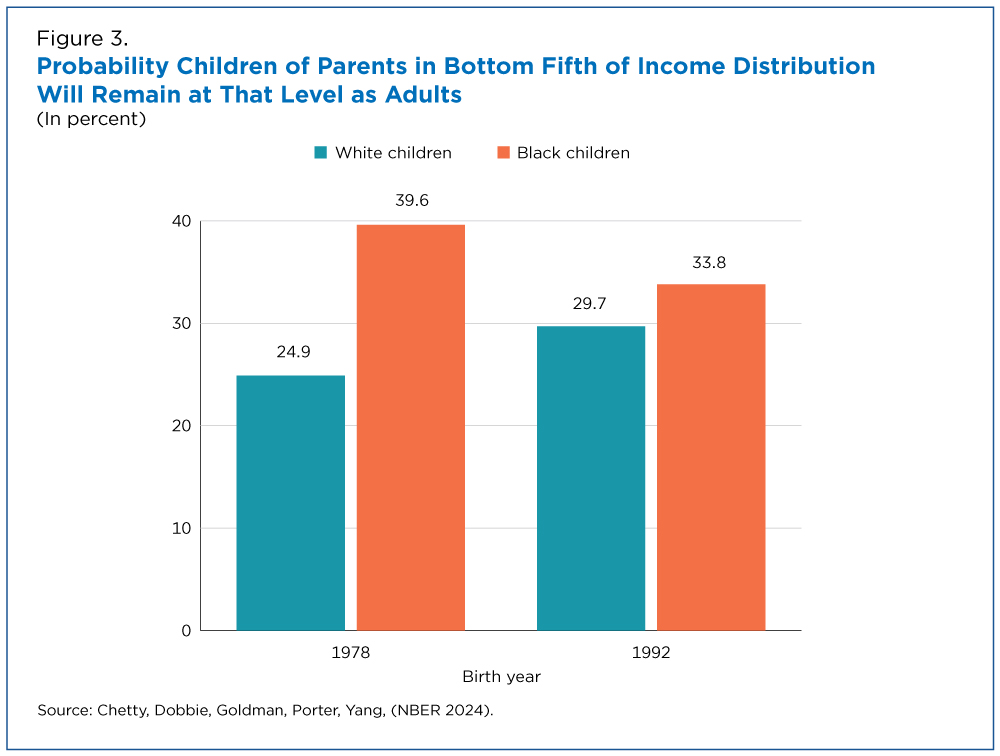While Low-Income Black-White Earnings Gap Narrowed, Gap Between Low- and High-Income White Young Adults Widened
While still large, the income “race gap” between low-income Black and White Americans narrowed but the “class gap” or the difference in earnings between young adults born to low- and high-income parents widened, according to U.S. Census Bureau and Harvard University research.
The new study focuses on how income mobility evolved between two generations 15 years apart.
While Black-White race gaps shrunk and White class gaps expanded in nearly every part of the country, the magnitude of these changes varied substantially across regions.
It begins with children born in 1978 and ends with those born in 1992. It uses children’s earnings at age 27 as the primary indicator of economic mobility, measured in 2005 for those born in 1978 and in 2019 for those born in 1992.
Shrinking Race and Growing Class Gaps
Consistent with prior research, the 1978 birth cohort shows marked disparities between Black and White children born to both low-income parents (the 25th percentile of the income distribution or an annual household income of about $26,000) and high-income parents (the 75th percentile of the income distribution or an annual household income of about $95,000).
On average, Black children born to low-income parents in the 1978 birth cohort went on to earn $12,994 less per year than their White counterparts. But for the 1992 birth cohort, the earnings gap, while still substantial, had shrunk by nearly a third to $9,521.
This shrinking race gap was due to both improvements in mobility for low-income Black children and declines in earnings for low-income White children.
At a national level, the research found little change in earnings outcomes for other race and ethnicity groups (Asian, American Indian or Alaska Native and Hispanic) across this time period.
In contrast, White children born to high-income parents in the 1978 cohort went on to earn $10,383 more than their low-income White counterparts. But for the 1992 cohort, the White “class gap” had increased by nearly a third to $13,202.
This growing class gap was due to both declining mobility for White children from low-income households and improvements in mobility of White children from high-income households.
There was little change in the class gap for Black children during this time because Black children born to high- and low-income parents experienced comparable improvements in earnings.
In addition to earnings, similar patterns of growing class gaps and shrinking race gaps were found across a broad range of outcomes, such as educational attainment, standardized test scores, marriage rates, and mortality which are described further in the new research.
Likelihood of Remaining Low-Income
The likelihood of growing up in a low-income household (defined here as the bottom fifth of the income distribution) and remaining low-income as an adult narrowed by nearly 75% between Black and White children born in 1978 and 1992, declining from an initial gap of 14.7 percentage points in 1978 to 4.1 percentage points by 1992.
This narrowing gap is attributable to both a 6-percentage point decrease in poverty persistence among Black children and a 5-percentage point increase in poverty persistence among White children.
Chances of Reaching the Top Income Tier
The likelihood of a Black or White child born to a low-income family reaching the top of the income distribution as a young adult remained the same between 1978 and 1992. However, White children born in 1992 were still 8.9 percentage points more likely to reach that level than their Black counterparts.
Regional and County Patterns in Mobility
To better understand these changes nationally, this study also looks at trends by county. While Black-White race gaps shrunk and White class gaps expanded in nearly every part of the country, the magnitude of these changes varied substantially across regions.
For White children from low-income families, economic mobility declined most in U.S. areas like the Great Plains and parts of the coasts that previously enjoyed relatively high mobility.
Outcomes for White children from low-income families remained stable in parts of the country like the Southeast and industrial Midwest where mobility was already relatively low.
For Black children from low-income families, mobility increased sharply in the Southeast and the industrial Midwest, with modest changes on the coasts.
Although mobility improved for Black children, significant earnings disparities between Black and White Americans persisted. This is because of the substantial initial gap between Black and White Americans in the 1978 birth cohort. The maps, which employ distinct and nonoverlapping color scales, demonstrate variations in mobility outcomes between these two groups.
Conditions in Prior Generations are Key Predictors
The research shows that children’s outcomes are closely related to changes impacting the parents in their neighborhood and particularly parents of the same race and class. The research refers to these changes as shifts in “community conditions.”
For example, the research found pronounced drops in mobility for low-income White individuals in communities where parental employment rates declined among low-income White parents.
Conversely, mobility improved for low-income Black individuals where employment rates for low-income Black parents increased.
While prior sociological research has highlighted employment as a powerful proxy for community conditions, we find similar patterns among other community conditions like marriage rates.
Ninety percent of income mobility gaps by race and class can be explained by changes in community conditions.
Childhood Environment and Influence of Social Communities
This research finds that the relationship between mobility and parent employment rates is a result of changes in childhood environment.
Social interactions, as opposed to changes in economic resources, have a greater impact on children’s outcomes. The research also demonstrates how children are most sensitive to changes in community conditions related to the parents of the kids they are most likely to be friends with based on age, race and class.
Improving Opportunity
Economic mobility can change within relatively short periods of time.
While previous research suggested the importance of targeting policy interventions at the neighborhood level, this study further identifies patterns of change at the community level as shaped by not only neighborhood, but by race, class and cohort.
These findings provide new data to understand how and where places are changing over time that may be used to inform policy focused on improving economic mobility.
This research includes new publicly available data on changes in mobility by county, birth cohort, race, class and sex, as well as a new interactive module within the Opportunity Atlas that allows you to explore mobility trends in your county.
Related Statistics
Subscribe
Our email newsletter is sent out on the day we publish a story. Get an alert directly in your inbox to read, share and blog about our newest stories.
Contact our Public Information Office for media inquiries or interviews.
-
PopulationNew Opportunity Atlas Estimates Social Mobility by Census TractThe new Opportunity Atlas shows which neighborhoods offer children the best chances of climbing the income ladder later in life.
-
Income and PovertyFresh Insights on Income Mobility From 2005 to 2019Mobility, Opportunity, and Volatility Statistics (MOVS) project shows income dynamics of working-age adults across socio-economic and geographic groups.
-
Income and Poverty2022 Income Inequality Decreased for First Time Since 2007U.S. Census Bureau income data released today show declines in real income at the middle and top of the income distribution from 2021 to 2022.
-
Business and EconomyExploring New Frontiers With the Quarterly Workforce IndicatorsJanuary 13, 2026New data on employment and hiring for detailed national industries enable data users to explore the composition and dynamics of specialized workforces.
-
Business and EconomyEconomic Census Highlights Variety of Products Many Industries SellJanuary 06, 2026North American Product Classification System (NAPCS) Data Release from the 2022 Economic Census is a treasure trove of unique information.
-
Business and EconomyRevenue and Employment Trends Reveal Shifts in U.S. EconomyDecember 30, 2025Revenue and employment losses in select retail industries continued, while online sales brokers and local delivery boomed.
-
EmploymentThe Stories Behind Census Numbers in 2025December 22, 2025A year-end review of America Counts stories on everything from families and housing to business and income.










